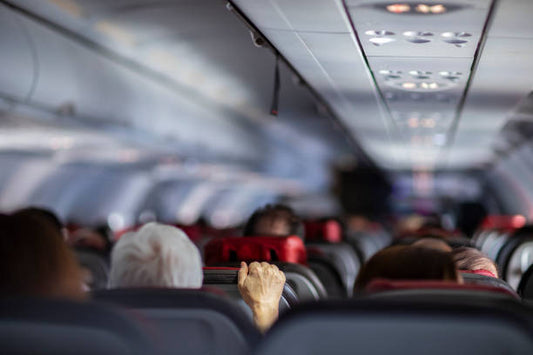Air travel can be such an exciting adventure! However, for some, it may bring along the pesky challenge of motion sickness. By learning about what causes this condition, travelers can feel more empowered to take steps that make their journey much more enjoyable. In this article, we’ll delve into the different aspects of motion sickness—from what it is to practical tips for preventing it.
Understanding Motion Sickness
What is Motion Sickness?
Motion sickness is a pretty common issue that many folks face, especially when they're in a moving vehicle. It happens because our brain gets mixed signals from different parts of our body, like our inner ear, eyes, and other areas, which can lead to everything from slight discomfort to feeling quite nauseous.
Although lots of people deal with motion sickness, the way it affects each person can really differ. Some might just feel a little off during car rides, while others might find it challenging to even think about flying without feeling queasy. This unpredictability can make motion sickness tricky for those who travel often.
Interestingly, studies have shown that certain groups may be more likely to experience motion sickness. For example, kids tend to be more sensitive because their vestibular systems are still developing, and women might notice a greater sensitivity during hormonal changes, like menstruation or pregnancy. Understanding these individual differences is essential for figuring out how to manage motion sickness effectively!
Why Does Motion Sickness Occur on Airplanes?
Airplane travel presents unique challenges that can exacerbate the symptoms of motion sickness. The rapid changes in altitude, turbulence, and the confined space of an aircraft can disorient passengers who are sensitive to motion. Additionally, modern planes are designed for efficiency, which can limit the visual cues that help stabilize an individual’s sense of balance.
The inner ear, responsible for maintaining balance, can become detached from the visual cues provided by the environment, leading to nausea and disorientation. This discrepancy is further aggravated by factors such as anxiety, cabin pressure changes, and potentially the smell of food or other passengers, all of which can trigger or heighten symptoms.
The psychological aspect of motion sickness cannot be overlooked. Many individuals may develop a fear of flying, which can create a self-fulfilling prophecy where anxiety exacerbates their physical symptoms. Techniques such as deep breathing, mindfulness, and visualization can help mitigate these feelings, allowing passengers to feel more in control during their flight. Understanding the interplay between physical and mental factors is essential for those who frequently travel by air and experience motion sickness, as it opens up avenues for effective coping strategies.
Recognizing the Symptoms of Motion Sickness
Physical Symptoms of Motion Sickness
Physical manifestations of motion sickness can significantly disrupt a traveler’s experience. Common physical symptoms include:
-
Nausea or vomiting
-
Dizziness or lightheadedness
-
Excessive sweating
-
Pallor or changes in complexion
-
Increased heart rate
Recognizing these symptoms early can be crucial. If travelers are aware of their bodies’ cues, they can implement prevention strategies more effectively. For instance, finding a stable position in a vehicle, such as sitting in the front seat or facing forward, can help mitigate feelings of nausea. Additionally, focusing on a fixed point in the distance can provide a sense of stability, allowing the inner ear and eyes to align better. Some travelers find that taking deep, controlled breaths can also ease the discomfort, as it helps to calm the nervous system and reduce the intensity of the symptoms.
Emotional Symptoms of Motion Sickness
It's not just the physical symptoms that can cause distress; emotional responses to motion sickness can be just as debilitating. Travelers may experience:
-
Anxiety or panic attacks
-
Feelings of helplessness
-
Increased irritability or mood swings
Combating these emotional symptoms often requires a combination of mental strategies and physical remedies to create a well-rounded approach to prevention and relief. Mindfulness techniques, such as meditation or visualization, can be particularly beneficial in managing anxiety. By focusing on calming imagery or practicing grounding exercises, travelers can divert their attention from the discomfort of motion sickness. Engaging in light conversation or listening to soothing music can serve as effective distractions, helping to alleviate feelings of panic and helplessness. Understanding that these emotional responses are common can also empower travelers, allowing them to approach their journey with greater confidence and resilience.
Pre-Flight Preparations to Prevent Motion Sickness
Choosing the Right Seat
A simple yet effective way to mitigate motion sickness is by selecting the optimal seat on the airplane. Research indicates that seating in the middle section of the plane, near the wings, can reduce the feeling of motion. This area tends to experience the least turbulence, providing a more stable ride. Sitting closer to the front of the aircraft can also help, as this section generally experiences less movement compared to the rear, especially during takeoff and landing.
Choosing a window seat allows passengers to look out at the horizon, helping to reconcile the conflicting sensory signals. This visual anchor can aid in maintaining balance and reducing the disorientation associated with motion sickness. Some travelers find it beneficial to focus on a fixed point in the distance, which can help stabilize their perception of motion. For those who prefer aisle seats, it’s important to be mindful of the need to stand up and stretch periodically, as this can also alleviate some of the discomfort associated with prolonged sitting in a confined space.
What to Eat and Avoid Before Your Flight
Diet choices before flying can greatly influence the likelihood of experiencing motion sickness. It's advisable to eat a light meal that is low in fats and sugars to prevent discomfort. Foods that may help stabilize the stomach include:
-
Crackers or toast
-
Bananas
-
Rice or plain pasta
-
Focus on hydration without excessive caffeine or alcohol.
Conversely, travelers should avoid heavy, greasy, or spicy foods, as well as carbonated beverages, which can contribute to bloating and nausea. Listening to one’s body can help one make the right dietary choices prior to boarding. Additionally, incorporating ginger into your pre-flight diet can be particularly beneficial, as it is known for its natural anti-nausea properties. Ginger tea, ginger ale (preferably non-carbonated), or even ginger candies can be great options to consider. Staying hydrated with water is crucial, but it's best to limit intake just before the flight to avoid frequent trips to the restroom during the flight, which can exacerbate feelings of unease.
Techniques to Prevent Motion Sickness During Flight
Breathing Techniques for Motion Sickness
Implementing breathing exercises can be an effective way to combat the symptoms of motion sickness once on board. Controlled breathing helps to calm the nervous system and can alleviate feelings of nausea. Some effective methods include:
-
Deep, diaphragmatic breathing: Inhale deeply through the nose, allowing the abdomen to rise, and exhale slowly through the mouth.
-
Counted breaths: Inhale for a count of four, hold for four, and exhale for a count of four.
Practicing these techniques can minimize anxiety and help the body regain composure during turbulent situations. Additionally, incorporating visualization techniques while breathing can enhance the effectiveness of these exercises. For instance, imagining a serene landscape or a calming scene can further distract the mind from discomfort, allowing for a more peaceful experience during the flight. It’s also beneficial to practice these techniques before your flight so they become second nature when you need them most.
Distraction Techniques to Keep Your Mind Off Motion Sickness
Focusing on something other than the discomfort can be pivotal in reducing feelings of motion sickness. Engaging in activities such as reading, listening to music, or playing games can effectively distract the mind. Additionally, watching a movie or series on a device can help soothe the mind and divert attention from symptoms.
Having a companion to talk to can be beneficial, as conversation can keep the mind occupied and make the flight seem shorter. Engaging with others can create a sense of normalcy that may counteract feelings of unease. If traveling alone, consider joining a group activity or participating in in-flight games offered by the airline, as these can provide both entertainment and a sense of community. Bringing along a journal to jot down thoughts or experiences can also serve as a productive distraction, allowing you to reflect on your journey while keeping your mind engaged. Such activities not only help manage motion sickness but can also transform your flight into a more enjoyable experience overall.
Over-the-Counter and Prescription Medications
Antihistamines for Motion Sickness
For those who find non-pharmacological methods insufficient, over-the-counter antihistamines can provide significant relief from motion sickness symptoms. Medications such as diphenhydramine (Benadryl) or meclizine (Antivert) have been shown to reduce nausea effectively. These medications work by blocking the action of histamine, a substance in the body that can trigger nausea and vomiting, particularly during travel.
It’s advisable to consult with a healthcare provider before using these medications, especially for individuals with preexisting conditions or those who are pregnant, as potential side effects such as drowsiness may occur. Additionally, some antihistamines may cause dry mouth or blurred vision, which can be uncomfortable for some users. It is also important to note that while these medications can be effective, they may not work for everyone, and some individuals may need to explore alternative options or combinations of treatments for optimal relief.
Scopolamine Patches and Other Prescription Options
Another option for serious cases of motion sickness is the use of scopolamine patches. These patches are placed behind the ear and deliver medication over time, preventing nausea effectively. They can be particularly useful for long flights or for individuals who frequently travel. The convenience of the patch allows for continuous medication delivery without the need for frequent dosing, making it a favored choice among travelers.
Always consult a healthcare professional before starting any prescription regimen, as they can provide guidance on dosage and potential interactions with other medications. In addition to scopolamine, there are other prescription medications available, such as promethazine, which can also help alleviate symptoms of motion sickness. These options may come with their own set of side effects, so understanding the full spectrum of potential reactions is crucial for safe and effective use. You may benefit from a combination of therapies, including both pharmacological and non-pharmacological strategies, to achieve the best results in managing your motion sickness symptoms.
Conclusion
Motion sickness can be quite a challenge for many travelers, but with a little understanding and some thoughtful preparation, it’s definitely possible to lessen its effects. By recognizing the symptoms, choosing comfortable seating, sticking to helpful dietary tips, practicing soothing breathing techniques, using some fun distractions, and exploring helpful medications, everyone can make their flying experience much more pleasant. For a natural alternative to common medications, Momma Bear Organics ginger lollipops are a great option! Each of these friendly strategies can really make air travel feel more enjoyable and a whole lot less intimidating.










